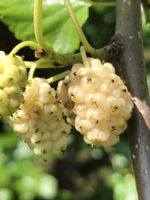Mon-Fri 9am - 5pm Mountain time
Boreal Beauty Haskap (Honeyberry) vs Russian White Mulberry
Lonicera caerulea Boreal Beauty
Morus alba tatarica
NOT AVAILABLE THIS SEASON - MIGHT RETURN
Boreal Beauty Haskap produces sweet/tart berries that have a great flavour. The flavour of Haskaps is generally described as a cross between a blueberry and a raspberry. Boreal Beast Haskaps are well suited to fresh eating, freezing, baking, and preserves.
The berries are heavy, firm, and have a great branch hold. They are firm enough to withstand mechanical harvesting.
For optimal fruit production, cross-pollination is required. Haskaps need to be planted with a compatible variety. Compatibility is influenced by both bloom time and genetics.
Boreal Beauty Haskap is a late-pollinating variety that pairs well with Boreal Beast.
Russian White Mulberry is a cold hardy and adaptable tree. It is a great choice for the impatient gardener as it reaches its mature height in a short period of time and has an attractive, dense, and rounded form.
Odd looking berries are produced among a backdrop of glossy, deep green foliage. The blackberry-esque berries ripen slowly over the season, ranging in color from white, pink, and purple-violet. While the berries are not well regarded for fresh eating, they have made tasty jams and preserves.

